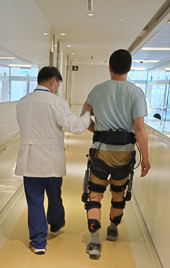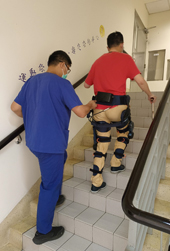
In an
era of rapid technological advancements, human potential is continually
expanding. One exciting area is the development of exoskeleton robots.
Specifically, lower limb exoskeleton robots, these wearable
electromechanical devices act like external leg muscles, directly augmenting
muscle strength, offering hope to those with mobility impairments, and
injecting new vitality into various industries.
A
lower limb exoskeleton robot, as its name suggests, is an external skeletal
structure worn on the human lower limbs. By integrating precise components such
as sensors, controllers, batteries, and actuators, these robots can simulate
and even enhance human leg functions. The machine detects the wearer's movement
intentions and provides additional strength and supports, assisting with daily
activities like standing, walking, and climbing stairs.
Giving Wings to Freedom: A New Dawn in Medical
Rehabilitation
Lower
limb exoskeleton robots show immense potential in the field of medical
rehabilitation, bringing renewed hope to many individuals who have lost the
ability to walk due to illness, accidents, or old age.
- Stroke Rehabilitation: Stroke patients often
face motor impairments in one or both limbs. Exoskeleton robots can
provide stable and repetitive gait training, helping patients relearn
correct walking patterns, promoting neuromuscular recovery, and enhancing
their ability to live independently. Through precise motion control and
data feedback, therapists can more effectively monitor patient progress
and adjust rehabilitation plans.
Clinical studies show that exoskeleton robots can
significantly improve patients' walking speed, stride length, and balance.
Additionally, some research has found that the repetitive, high-intensity
training provided by exoskeleton robots can promote neuroplasticity after a
stroke, accelerating the recovery of motor function.
- Spinal Cord Injury: For patients with spinal
cord injuries, standing and walking again were once distant dreams.
However, advanced exoskeleton robots can provide sufficient support,
helping them overcome gravity to stand and walk slowly. This not only
helps improve their physical health, such as preventing bedsores, osteoporosis,
and cardiovascular diseases, but also significantly enhances their quality
of life and psychological well-being, all of which have been clinically
proven.
- Cerebral Palsy and Other
Neuromuscular Diseases: Lower limb exoskeleton robots can also provide assistive mobility
and gait training for patients with neuromuscular diseases such as
cerebral palsy, multiple sclerosis, and muscular dystrophy. For some
patients with impaired walking ability, exoskeleton robots can provide
precise motion control and repetitive training, helping them recover
muscle strength, coordination, and balance more quickly. Physical
therapists can utilize exoskeleton robots to guide patients through more
complex movement patterns and monitor patient movement data in real-time
to adjust treatment plans.
- Elderly Assisted Care: For the elderly or
patients with lower limb weakness due to other diseases, lightweight
exoskeleton robots can serve as an assistive tool, providing additional
support to help them maintain daily activities such as standing, walking,
and climbing stairs, thereby improving their independence and quality of
life.
- Occupational Applications: In industries such as
construction, logistics, and manufacturing, workers often need to carry
heavy objects or stand and walk for long periods, which can lead to muscle
fatigue and occupational injuries. Wearing lower limb exoskeleton robots
can provide additional strength and support, reducing the physical burden
on workers and improving work efficiency and safety. For example, some
exoskeletons can help workers easily carry dozens of kilograms of heavy
objects, or provide leg muscle support during prolonged standing, reducing
fatigue.
Technical Challenges and Future Outlook
Despite
significant progress in lower limb exoskeleton robots, several technical
challenges remain:
- Weight and Battery Life: Many current exoskeleton
robots are still relatively heavy, and their battery life is limited,
which restricts their long-term use and portability. The future requires
the development of lighter, more efficient materials and energy systems.
- Precision and Naturalness
of Control Systems: How to more accurately sense the wearer's movement intentions and
make the robot's movements more natural and fluid is key to improving user
experience. This requires more advanced sensing technologies, more complex
control algorithms, and smarter human-machine interfaces.
- Cost and Popularity: The current cost of lower
limb exoskeleton robots is still high, limiting their widespread
application. As technology matures and production scales expand, costs are
expected to gradually decrease, allowing more people to benefit from this
technology.
- Safety and Comfort: The comfort and safety of
wearing exoskeleton robots for extended periods are crucial. Designs need
continuous improvement to be more ergonomic, reduce friction and pressure
points, and ensure stability and safety in various situations.
Lower
limb exoskeleton robots are expected to gradually break physical limitations as
technology develops, empowering humans with stronger mobility and ushering in a
future full of possibilities. Let's wait and see how this technology will
continue to evolve and bring more profound impacts to human society.

